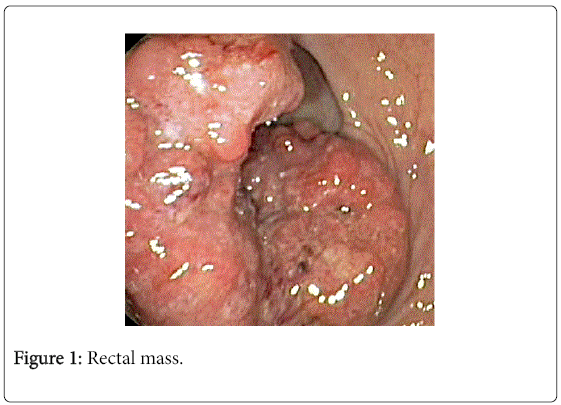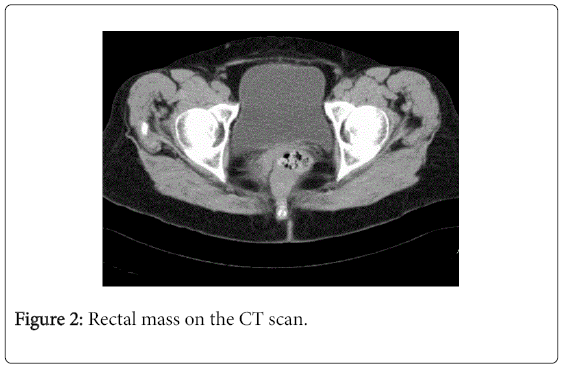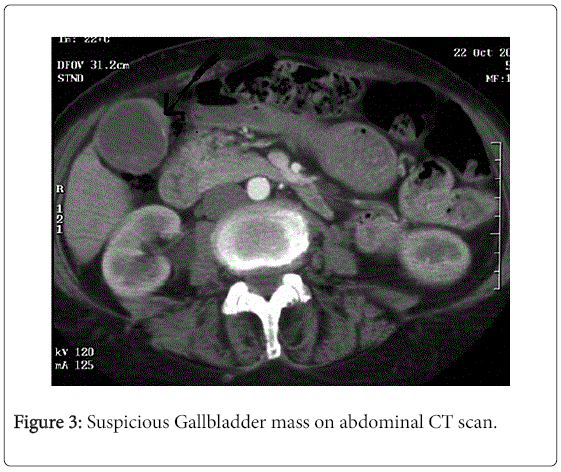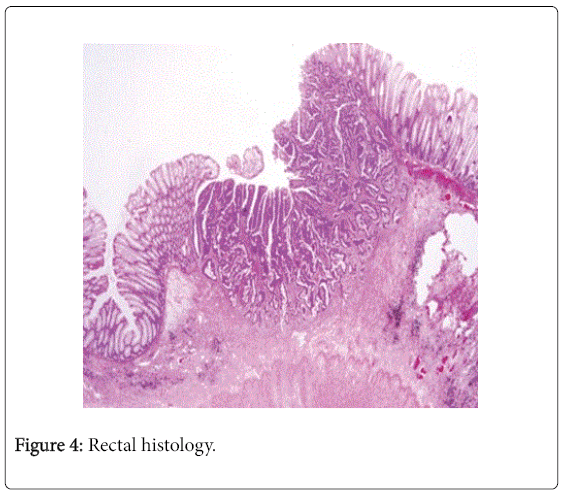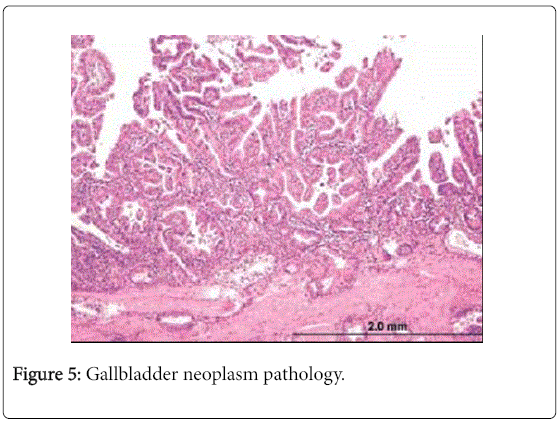Case Report Open Access
Primary Gallbladder and Rectal Neoplasms: Rare Synchronous Digestive Tumors
Elias Makhoul*, Yara Assaf and Anthony Zaarour
Department of Gastroenterology and Hepatology University Hospital Notre Dame de Secours, Byblos, Lebanon
- Corresponding Author:
- Makhoul Elias, MD
Department of Gastroenterology and Hepatology
Faculty of medicine and sciences Holy Spirit University
University hospital Notre Dame De Secours Jbeil Byblos, BP: 3, Byblos Lebanon
Tel: +9613711787
E-mail: eliemakhoul@hotmail.com
Received date: April 25, 2016; Accepted date: June 02, 2016; Published date: June 09, 2016
Citation: Makhoul E, Assaf Y, Zaarour A (2016) Primary Gallbladder and Rectal Neoplasms: Rare Synchronous Digestive Tumors. J Gastrointest Dig Syst 6:435. doi:10.4172/2161-069X.1000435
Copyright: © 2016 Makhoul E, et al. This is an open-access article distributed under the terms of the Creative Commons Attribution License; which permits unrestricted use; distribution; and reproduction in any medium; provided the original author and source are credited.
Visit for more related articles at Journal of Gastrointestinal & Digestive System
Abstract
Colorectal cancer, the third most common cause of cancer worldwide and the fourth leading cause of cancer death is known to be a major cause of morbidity and mortality. Furthermore, the gallbladder cancer, a rare tumor, occupies the fifth place among the cancers of the gastrointestinal tract.
Keywords
Synchronous; Adenocarcinoma; Rectum; Gallbladder
Introduction
Colorectal cancer, the third most common cause of cancer worldwide and the fourth leading cause of cancer death is known to be a major cause of morbidity and mortality [1,2]. Furthermore, the gallbladder cancer, a rare tumor, occupies the fifth place among the cancers of the gastrointestinal tract [1-3].
Colorectal neoplasia is usually associated with multiple primary cancers. The synchronous presence of rectal and gallbladder malignancies is one of the extremely rare associations [4]. The treatment should be tailored according to the characteristics and clinical aspects of presentation. Generally the most incriminated risk factors in the occurrence of synchronous primary tumors are the environmental, genetic, immunological and iatrogenic factors [1].
Herein, we present the case of a patient diagnosed with rectal carcinoma and incidental detection of synchronous gallbladder cancer during the staging process of the first tumor.
Clinical Case
A 67 year-old male patient, with no past medical or surgical history presented with diffuse abdominal pain, hematochezia, progressive constipation and a weight loss of six kilograms during the last four months. As for the family cancer history, his mother had colorectal cancer diagnosed at the age of 55. No other complaints were noted.
The patient was hemodynamically stable but digital rectal exam revealed a firm vegetating and circumferential tumoral lesion at the lower rectum. Laboratory investigations disclosed low hemoglobin (8 g/dl) as the only positive laboratory finding. CA 19-9 level was normal while CEA was found to be moderately elevated (25 mg/ml). The colonoscopy evidenced an ulcerated and elevated rectal mass arising at 4 cm away from the anus, occupying 70% of the lumen (Figure 1).
The rest of the endoscopic exam was normal. Multiple biopsies of this growth were taken and showed a moderately differentiated adenocarcinoma of the rectum. Contrast enhanced CT scan of the abdomen and pelvis aiming at a staging evaluation was performed and evidenced a circumferential rectal mass (Figure 2), sigmoid colon dilatation and incidental detection of an abnormal suspicious gallbladder wall thickening of more than 3 mm (Figure 3). No signs of metastatic disease were noted. No other relevant findings were detected. The chest X-ray was normal.
The patient underwent an open abdominoperineal resection in addition to cholecystectomy. He recovered well from the operation with no complications and was discharged on the 6th postoperative day.
Rectal histopathology demonstrated a moderately differentiated adenocarcinoma around 4 cm of length, with free distal and proximal borders and infiltration of the visceral peritoneum (Figure 4). Metastases in 4 of 6 identified lymph nodes were found, and the pathological staging for this specimen was T4N2M0.
Gallbladder histopathology evidenced moderately differentiated adenocarcinoma invading the muscular layer with no lymph node involvement, classified T2N0M0 (Figure 5).
The Patient was sent to surgery for large liver resection and referred to oncology department for adjuvant therapy.
Discussion
The colon is the most involved organ in the occurrence of synchronous cancers [3,5] especially in advanced age patients. The incidence of multiple primary cancers in the colon and rectum accounts from 2-5% [6,7]. Presence of sporadic synchronous carcinomas of the rectum and gallbladder is a rare presentation and the incidence is of 4.3% for gastrointestinal tract malignancies [5,8]. In fact, patients suffering from Lynch syndrome (Hereditary nonpolyposis colorectal cancer) and Peutz-Jeghers syndrome (PJS) have a higher risk of biliary tract malignancy and colorectal malignancy [2].
Billroth in 1889 was the first to describe multiple malignancies. It would be interesting to note that during the recent years the occurrence of multiple tumors increased due to the improved average age of survival. We note also that the development of new techniques and screening procedures has allowed an earlier and reliable detection of associated tumors [4,9]. In fact the precise determination of the occurrence of multiple primary cancers remains difficult because often the second cancer can be mistaken as a recurrence or metastases of the first cancer.
Above all, second carcinomas have a key role in determining the prognosis and life expectancy of the patient because the standard curative treatment is resection of each tumor whenever it is possible [3,9]. There are no well-defined guidelines for the treatment of patients presenting with multiple malignancies and it’s still controversial [2]. The decision making for work up, management and follow-up of these patients will be instituted according to the guidelines of each malignancy.
Besides, it is important to note that double primary malignancies can be divided into synchronous and metachronous cancers depending on the interval between tumor diagnosis. Synchronous cancers are those diagnosed at the same time or within six months and metachronous cancers are those diagnosed within six months or more time interval from each other [1]. This classification is based on Warren and Gates criteria [4,9,10], depending on the histological confirmation of malignancy in both primary tumors, a 2 cm normal mucosa between the two cancers and if the second tumor arises in the same location they should be separated by at least five years of time and finally the hypothesis that the second cancer is a metastasis or recurrence of the first one must be excluded.
Several hypotheses explain the increase in the incidence of multiple primary cancers such as exposure to carcinogens and genetic alterations. Horii and et al. [11] emphasized on the major role of microsatellite instabilities (MSI) due to mutations in mismatch repair genes (MMR) [2]. 10% of cancer patients develop a second primary cancer within ten years of diagnosis and treatment of the first one [11]. The role of MSI in sporadic multiple primary malignancies was underlined by its involvement in Lynch syndrome due to MMR genes mutation leading to this instability [2]. 2-4% is the probability of developing a biliary tract malignancy in Lynch syndrome [2,12]. The occurrence of colorectal and gallbladder cancer is also increased in (PJS). It’s important to note that our patient doesn’t fulfill the criteria of Lynch syndrome or PJS.
To prove if a genetic defect involving the DNA repair and replication system is present, it would be interesting to examine the replication errors (RER) at microsatellites loci on different chromosomes. If the RER phenotype is positive it is in favor of the occurrence of multiple primary cancers. It would be appropriate to test the RER phenotype in patients affected by a primary cancer to detect among them the highest risk patients [2,11].
In addition, the combination of cytokeratin (CK) expression CK7 and CK20 is considered to be used for the differential diagnosis of carcinomas originating from different sites. In our case, we did not perform immunohistochemical analysis, because there are very few reports in the literature regarding the clinical significance of immunohistochemical markers in gallbladder carcinoma. Furthermore, no gallbladder metastasis of colorectal cancer is described in the literature.
A special attention should be given to the link existing between colorectal and gallbladder carcinomas. Some studies suggest that their simultaneous occurrence is mainly due to gallstones and not to the genetic or hereditary risk [13]. In reality, the fecal excretion of bile acids is increased in patients suffering from colorectal cancer and those who have undergone cholecystectomy. This is the reason that incited the researchers to insist on this association between these malignancies [13].
It’s important to note that there is no clear data revealing the frequency of occurrence of the colon and gallbladder cancers, and rectum and gallbladder cancers separately. We have to underline the fact that colon and gallbladder tumors association is rare. Rectum and gallbladder carcinomas association is even rarer [2,4,5,13].
In this report, the patient was diagnosed with rectal adenocarcinoma and while accomplishing the preoperative staging with an abdominal and pelvic CT scan, a newly-diagnosed gallbladder synchronous cancer was observed and confirmed histologically after surgery.
Conclusion
The simultaneous occurrence of rectal and gallbladder malignancies is rare. The mechanism of this phenomenon is not yet clarified but several hypotheses emphasize on the role of genetic factors. The treatment must be specific for each tumor because the life expectancy and prognosis depend on both while the management should be considered according to the malignancy presenting the worst prognosis.
References
- Geraldo I, Raquel CM, Caroline MN, Leandro B, Daniel C, et al. (2014) Gallbladder and Rectal Synchronous Adenocarcinoma: Case Report. Journal of gastroenterology and hepatology research 3: 12.
- Gupta V, Goel MM, Kumari M, Noushif M, Gandhi JS, et al. (2014) Non-Familial synchronous double primary malignancies of the gallbladder and rectum. Journal of gastrointestinal cancer.
- Lee TK, Barringer M, Myers RT, Sterchi JM (1982) Multiple primary carcinomas of the colon and associated extracolonic primary malignant tumors. Ann Surg 195: 501-507.
- Sakellaridis T, Mathioulakis S, Antiochos C (2005) Synchronous early primary adenocarcinoma of both rectum and gallbladder. Report of a case. International Seminars in Surgical Oncology 2: 19.
- Arai T, Sawabe M, Takubo K, Kanazawa K, Esaki Y (2001) Multiple colorectal cancers in the elderly: a retrospective study of both surgical and autopsy cases. J Gastroenterol 36: 748-752.
- Cunliffe WJ, Hasleton PS, Tweedle DE, Schofield PF (1984) Incidence of synchronous and metachronous colorectal carcinoma. Br J Surg 71: 941-943.
- Evers BM, Mullins RJ, Matthews TH, Broghamer WL, Polk HC Jr (1988) Multiple adenocarcinomas of the colon and rectum. An analysis of incidences and current trends. Dis Colon Rectum31: 518-522.
- Minni F, Casadei R, Marrano N, Guerra E, Piccoli L, et al. (2005) [Second tumours in patients with malignant neoplasms of the digestive apparatus. A retrospective study on 2406 cases]. Ann Ital Chir 76: 467-472.
- Tamura M, Shinagawa M, Funaki Y (2003) Synchronous triple early cancers occurring in the stomach, colon and gallbladder. Asian J Surg 26: 46-48.
- Warren S, Gates O (1932) Multiple primary malignant tumors: A survey of the literature and statistical study. Am J Cancer 16: 1358-1414.
- Horii A, Han HJ, Shimada M, Yanagisawa A, Kato Y, et al. (1994) Frequent replication errors at microsatellite loci in tumors of patients with multiple primary cancers. Cancer Res 54: 3373-3375.
- Chessin DB, Guillem JG (2007) Colorectal polyps, polyposis syndromes, and hereditary nonpolyposis colorectal cancer. In: Yeo CJ, editor. Shackelford’s surgery of the alimentary tract, vol. 2. 6th ed. Philadelphia: Elsevier 2169-2175.
- Alruwaii ZI, Shawarby MA (2015) Synchronous primary colonic and early gallbladder carcinomas: report of a rare case Case Reports in Clinical Pathology.
--
Relevant Topics
- Constipation
- Digestive Enzymes
- Endoscopy
- Epigastric Pain
- Gall Bladder
- Gastric Cancer
- Gastrointestinal Bleeding
- Gastrointestinal Hormones
- Gastrointestinal Infections
- Gastrointestinal Inflammation
- Gastrointestinal Pathology
- Gastrointestinal Pharmacology
- Gastrointestinal Radiology
- Gastrointestinal Surgery
- Gastrointestinal Tuberculosis
- GIST Sarcoma
- Intestinal Blockage
- Pancreas
- Salivary Glands
- Stomach Bloating
- Stomach Cramps
- Stomach Disorders
- Stomach Ulcer
Recommended Journals
Article Tools
Article Usage
- Total views: 13290
- [From(publication date):
June-2016 - Apr 01, 2025] - Breakdown by view type
- HTML page views : 12324
- PDF downloads : 966

